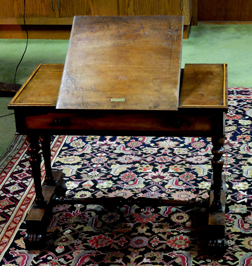Browning Desks, Tea Kettle on Display In Firestone Library, Rare Books Dept.


WOULD WOOD COULD SPEAK: The writing desk used by Elizabeth Barrett Browning as she worked on her poems in Italy is on display in the Department of Rare Books and Special Collections at Princeton University Library. The desk and one other belonging to her husband Robert Browning are the gift of alumnus Peter N. Heydon, (Class of 1962) and will be on display at the Firestone Library through June 6. (Photo by Don C. Skemer)
Robert and Elizabeth Barrett Browning’s love story is one of the most famous in 19th century literature. Elizabeth Barrett (1806-1861), one of the most prominent English poets of the Victorian era, was widely popular in Britain and the United States. An invalid from her teenage years, she campaigned against slavery and helped bring about child labor reform.
Robert Browning (1812-1889), six years her junior, was regarded as a bit of a rake by her family. They kept their burgeoning love affair a secret and when they married, Elizabeth was disinherited by her father and shunned by her brothers.
Two desks, his and hers, are on display inside the Special Collections library at Firestone behind the glass window to the right of the entrance doors. Even in the dim light, the desks have a presence “by association” to their former owners. Both are remarkably small and weathered. Hers is more ornately carved, his is inlayed with tendrils of roses, but neither could be called ostentatious.
“The desks have what is known in the book world as iconic value precisely because there can be no substitutes for them, unlike a book of which there are many copies,” said Curator of Manuscripts Don C. Skemer of the Department of Rare Books and Special Collections. “Seeing her writing desk is a charming and moving experience. The Brownings had a very special relationship. She was often housebound and her disability has been much speculated upon and yet they ran off to Florence together and lived happy and productive lives until her death several decades before her husband.”
To live cheaply, the couple moved to Italy in 1846. Her slant-topped mahogany writing desk was sent from England shortly after they arrived and placed in the drawing room of their rented apartment on the second floor of the 15th-century Palazzo Guidi in Florence.
Writing Her Life
“Elizabeth Barrett Browning wrote her ‘novel in verse,’ Aurora Leigh, on this desk and while it’s not as well known as her collection, Sonnets from the Portuguese, its part of the canon as an epic poem about a woman written by a women,” noted Mr. Skemer.
Aurora Leigh is the story of a female writer making her way and balancing work and love and is clearly drawn from her own life: “Of writing many books there is no end; / And I who have written much in prose and verse / For others’ uses, will write now for mine.”
While living in Italy, Elizabeth suffered four miscarriages and, in 1849, at the age of 43, gave birth to one son, Robert “Pen” Browning (1849–1912).
“After her death, her husband was unable to go back to their Casa Guidi apartment and returned to England,” said Mr. Skemer, “but he asked his Greek painter friend, George Mignaty, to record the scene for him as a remembrance of their happy and productive years in Florence.”
In Mignaty’s oil painting, begun the day after Elizabeth’s death on July 1, 1861, the desk sits prominently, front and center alongside her husband’s Northern Italian walnut table as well as silver-plated “traveling” tea kettle, also on display at Firestone.
The University received the items as a gift from alumnus Peter N. Heydon (Class of 1962). They were originally sold at auction in 1913 following the death of the Brownings’ son and heir.
“The University doesn’t own Mignaty’s painting, but Mr. Hayden has a copy that he is planning to donate,” said Mr. Skemer. The items currently on display are the first of several anticipated gifts to Princeton from Mr. Heydon’s extensive collection of Browning first editions, manuscript letters, and other Victorian memorabilia collected over four decades.
Mr. Heydon first became enchanted with the poetry of Robert Browning as a Princeton undergraduate. At the University of Michigan, he earned both MA (1963) and PhD (1970) and then taught English literature and creative writing. He is the founding president of The Browning Institute, Inc., based in New York and Florence, which acquired the Casa Guidi apartment in 1971. As the Institute’s president for 15 years, he oversaw the restoration of the apartment as a museum and study center, now owned and operated, like the Keats-Shelley House in Rome, by Eton College and the British National Trust.
Mr. Heydon has authored a number of pieces on Robert Browning and his circle; he was co-editor with Philip Kelly of Elizabeth Barrett Browning’s Letters to Mrs. David Ogilvy, 1849–1861: With Recollections by Mrs. Ogilvy (New York: Quadrangle Press, 1973).
Other Browning holdings in the Department of Rare Books and Special Collections include dozens of manuscripts and autograph letters, held in the Manuscripts Division..

